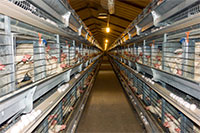Preventing Physical Hazards from Entering the Food Supply
By Leah Roberts
There are many aspects to food safety but according to the Canadian Food Inspection Agency, the leading cause of consumer complaints in that country relates to the discovery of foreign objects in food products. Although the number of occurrences is apparently becoming less frequent, food manufacturers are well-advised to be vigilant: in many jurisdictions, not just Canada, it’s “The Law” to do so, and it’s also important in maintaining your brand’s reputation. Not all extraneous materials render a food unsafe for consumers, and many would agree that it’s impossible to eliminate all physical hazards in food production. But today’s food safety management systems strive to identify and prevent hazards, rather than just simply react to the contaminant after it’s been identified.
Controlling Physical Hazards
One of the most important steps in controlling physical hazards is to implement a HACCP plan. It supports the food safety and quality of a product through specified performance standards and testing procedures.
As a food safety concept, HAACP covers all stages of the production process at critical control points and requires detailed information for every step along the food processing line. By closely observing all phases of the operation, food processors can clearly identify the physical hazards and implement preventive measures, such as metal detectors or x-rays, as a Control Point in their HACCP plan.
Using standard quality assurance programs, such as Good Manufacturing Practices (GMP) or ISO 9000, can also ensure that certain hazards are controlled. Requiring employees to wear a hairnet to prevent hair contamination, for example, would fall into this category as something that is deemed preventable.
Establishing agreements and ingredient specification commitments There may be benefits in inspecting throughout the process as well.with raw materials suppliers is another way that food processors can ensure that all food products entering their facility have been processed with physical hazard controls in place.
Certification
With these preventative and control methods in place, vendors can apply to outside registrars to certify their food products to one of the globally recognized food standards under GFSI such as: BRC, SQF, IFS and GlobalGAP to name a few.
Stephen Young, President of Onguard Product Inspection, says there is an alternative to certification that doesn’t involve following a regimented, codified program.
“Sometimes [food processors] ask an outside party, be it the equipment manufacturer or a consultant such as OnGuard, to independently test and certify the performance of their contaminant detection systems,” he says.
OnGuard Product Inspection Inc., for example, provides x-ray inspection services to help food processors assess incoming ingredients prior to processing, but most often they respond when a problem has already been identified with a finished product and sometimes after a consumer complaint.
Shift to Implement Food Safety Management Systems
Although these tools can identify a loss of control and implement a corrective action, control programs cannot guarantee that physical hazards will not make it into the product.
Robert Rogers, Senior Advisor on Food Safety and Regulations at Mettler Toledo, sees a shift in the industry to implement programs and processes to prevent hazards as opposed to simply detecting them.
“Facilities often look at metal detection and x-ray inspection as an end-of-the-line inspection on the final product. Although the end of the line is a good position for inspection, as further contamination is reduced due to it being in a closed, final package, there may be benefits in inspecting throughout the process as well,” says Rogers.
His company, Mettler Toledo, provides consultation and training, installation and qualification services, ongoing performance verification, and certification services throughout the food supply chain, as well as, supply detection and removal for physical hazards.
Rogers says that maintaining thorough documentation, undertaking root cause analysis and implementing corrective actions as soon as a potential problem is identified, all allow facilities to improve their systems, prevent further incidents and increase efficiency.
“Certainly (with) the increased focus on food safety programs, like GFSI certified programs, and the final rules for the new Food Safety Modernization Act (coming through) facilities are more focused on their entire food safety program, including controls for physical hazards,” Rogers adds.
About the Author
Leah Roberts is an Ontario-based writer and digital marketing expert with a keen interest in food safety and sustainability practices.
To have more articles like this emailed to your inbox, become a GFSR Member today!

-
 FeaturedRisk management
The Cost of a Breach: What a Cyberattack Could Mean for Food Safety Recalls
FeaturedRisk management
The Cost of a Breach: What a Cyberattack Could Mean for Food Safety Recalls
-
 FeaturedRisk management
Securing the Food Chain: How ISO/IEC 27001 Strengthens Cybersecurity
FeaturedRisk management
Securing the Food Chain: How ISO/IEC 27001 Strengthens Cybersecurity
-
 FeaturedRisk management
Revolutionizing Food Safety Training: Breaking Out of the “Check-the-Box” Mentality
FeaturedRisk management
Revolutionizing Food Safety Training: Breaking Out of the “Check-the-Box” Mentality
-
 GFSI Standards
GFSI 2025: Building Trust, Tech-Forward Solutions, and Global Unity in Food Safety
GFSI Standards
GFSI 2025: Building Trust, Tech-Forward Solutions, and Global Unity in Food Safety
-
 FeaturedFood Safety
Integrated Pest Management: Strategies to Protect Your Brand’s Reputation
FeaturedFood Safety
Integrated Pest Management: Strategies to Protect Your Brand’s Reputation
-
 FeaturedFood Safety Culture & Training
No Open Door Policy: Challenges That Impact Pest Control in Food Processing Plants
FeaturedFood Safety Culture & Training
No Open Door Policy: Challenges That Impact Pest Control in Food Processing Plants




